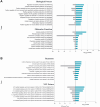Identification of Biomarkers Related to the Efficacy of Radiotherapy in Pancreatic Cancer
- PMID: 37643780
- PMCID: PMC10464945
- DOI: 10.21873/cgp.20400
Identification of Biomarkers Related to the Efficacy of Radiotherapy in Pancreatic Cancer
Abstract
Background/aim: Pancreatic cancer (PC) has one of the highest mortality rates, with an overall five-year survival rate of only 7%. When diagnosed, PC is limited to the pancreas in only 20% of patients, whereas in 50% it has already metastasized. This is due to its late diagnosis, which makes the treatments used, such as radiotherapy, difficult, and reduces survival rates. Therefore, the importance of this study in detecting genes that may become possible biomarkers for this type of tumor, especially regarding the human secretome, is highlighted. These genes participate in pathways that are responsible for tumor migration and resistance to therapies, along with other important factors.
Materials and methods: To achieve these goals, the following online tools and platforms have been expanded to discover and validate these biomarkers: The Human Protein Atlas database, the Xena Browser platform, Gene Expression Omnibus, the EnrichR platform and the Kaplan-Meier Plotter platform.
Results: Our study adopted a methodology that allows the identification of potential biomarkers related to the effectiveness of radiotherapy in PC. Inflammatory pathways were predominantly enriched, related to the regulation of biological processes, primarily in cytokine-derived proteins, which are responsible for tumor progression and other processes that contribute to the development of the disease.
Conclusion: Radiotherapy treatment demonstrated greater efficacy when used in conjunction with other forms of therapy since it decreased the expression of essential genes involved in several inflammatory pathways linked to tumor progression.
Keywords: Pancreatic cancer; bioinformatics; biomarker; radiotherapy; resistance; secretome.
Copyright © 2023, International Institute of Anticancer Research (Dr. George J. Delinasios), All rights reserved.
Conflict of interest statement
The Authors declare no conflicts of interest.
Figures






Similar articles
-
The Expression and Survival Significance of Glucose Transporter-1 in Pancreatic Cancer: Meta-Analysis, Bioinformatics Analysis and Retrospective Study.Cancer Invest. 2021 Oct;39(9):741-755. doi: 10.1080/07357907.2021.1950755. Epub 2021 Aug 3. Cancer Invest. 2021. PMID: 34229540
-
Integrated bioinformatics analysis of potential biomarkers for pancreatic cancer.J Clin Lab Anal. 2022 May;36(5):e24381. doi: 10.1002/jcla.24381. Epub 2022 Apr 11. J Clin Lab Anal. 2022. PMID: 35403252 Free PMC article.
-
Identification of novel genes associated with a poor prognosis in pancreatic ductal adenocarcinoma via a bioinformatics analysis.Biosci Rep. 2019 Aug 2;39(8):BSR20190625. doi: 10.1042/BSR20190625. Print 2019 Aug 30. Biosci Rep. 2019. PMID: 31311829 Free PMC article.
-
Phyto-targeting the CEMIP Expression as a Strategy to Prevent Pancreatic Cancer Metastasis.Curr Pharm Des. 2022;28(11):922-946. doi: 10.2174/1381612828666220302153201. Curr Pharm Des. 2022. PMID: 35236267 Review.
-
Implications of prognosis-associated genes in pancreatic tumor metastasis: lessons from global studies in bioinformatics.Cancer Metastasis Rev. 2021 Sep;40(3):721-738. doi: 10.1007/s10555-021-09991-1. Epub 2021 Sep 30. Cancer Metastasis Rev. 2021. PMID: 34591244 Free PMC article. Review.
References
MeSH terms
Substances
LinkOut - more resources
Full Text Sources
Medical
